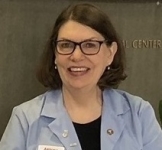When you hear the phrase “telehealth connections,” you probably think of the literal connection—through wires or Wi-Fi, through dedicated circuits or the internet—between the patient and the health-care provider.
But one telemedicine program is taking pains to ensure that telehealth includes a strong human connection, too.
“If your provider and patient don’t feel like they connected, they won’t come back,” says Gigi Sorenson, System Director of Telehealth and Community Connected Care for Northern Arizona Healthcare (NAH). Sorenson’s team has been conducting patient satisfaction surveys for NAH’s remote patient monitoring and telemedicine clinics for nearly five years.
“We survey patients and their families as to the experience and we also survey the providers. And we separate that from the technology quality,” she says. Technology quality would include, “did we lose audio, did we lose video, were there freezes.”
Sure, the technology quality is likely to have an impact on the patient’s and provider’s experience, but that’s not the whole story, says Sorenson. She points to a clinic NAH runs in very rural Peach Springs, AZ, where chronic cardiac patients connect with dietitians in Flagstaff. “The A/V is horrendous,” she says, “A one- to two-second delay. But both the dietitian and the patients are saying, ‘no, no, as long as we can see the person at the other end it’s okay,’ because they feel physically connected by being able to see the other person.”
Conversely, perfect A/V does not guarantee a good connection between provider and patient, Sorenson says. “Even if the technology works great, if your patients think it’s sterile, you’re not going to be successful.” For example, in a Children’s Rehabilitative Services clinic run by NAH, a mother complained early on that she didn’t feel the telemedicine encounter was a “real visit” because the doctor never touched her son. At the next visit, the doctor brought up the mom’s concern and said, “in our in-person visits, I’ve never touched your son except to hug him at the end, and I don’t need to touch him.” The doc also explained that telemedicine allowed him to spend much more focused time with each patient without distractions. He offered to set up a hug from one of the clinicians at the patient’s site at the end of each visit, and the boy now gets hugs from the nurse case manager. With their concerns addressed, that family is still coming to clinics.
NAH surveys clinic patients about once a month, asking them to rate the quality of care they received using telemedicine, how likely they are to use telemedicine again to see their health-care provider, and how likely they are to recommend telemedicine to a friend or family member. Providers also are surveyed, with questions including “were you able to obtain the information you needed to treat the patient’s problem?” “did you feel the encounter was successful?” and “would you do a telehealth clinic again?”
Remote patient monitoring (RPM) program participants are surveyed as well. One provider said, “We have talked through so many issues with patients by having them monitor their oxygen levels or blood pressure while on the phone with one of the nurses, saving a trip to the emergency department.”
RPM patients know that NAH telehealth nurses will come to them in person or send a public health nurse if there is an issue or will send them whatever they need—batteries, for instance—and then call and walk them through how to install them.
Comments from RPM patients—or even the patients’ family members—are along the lines of, “We felt safe having Mom by herself because she knew she could always connect with you,” says Sorenson. One family member of a patient who passed away while in the program took the time to fill out the survey, saying, “Knowing Mom was so sick but we could keep her home and monitor everything with our nurse watching over us meant so much. We were not alone.”
The RPM technology consists of a cell phone and peripheral devices that make it possible for patients to be in contact with the NAH telehealth nurses whenever needed, but it’s the human connection that makes the program successful.
“It’s the relationships that we have been able to develop with these patients that matter most,” Sorenson says. “They know someone is watching out for them.”

